新译林版英语四年级上册第二单元教案
(译林版)四年级英语上册 Unit2 Let's make a fruit salad教案(全单元教案)
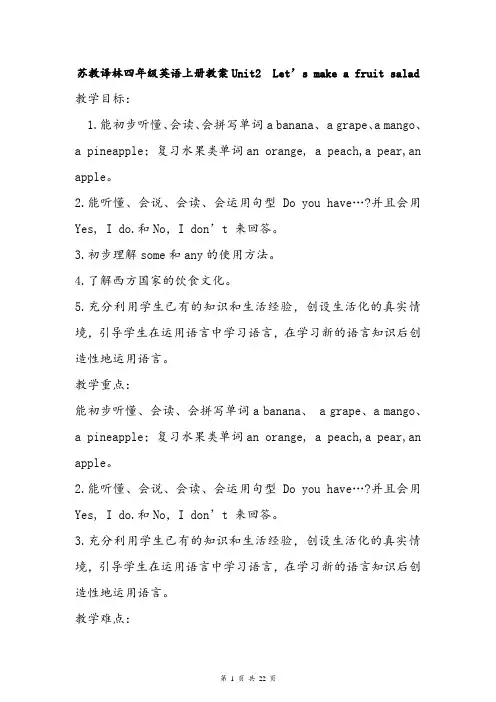
苏教译林四年级英语上册教案Unit2 Let’s make a fruit salad 教学目标:1.能初步听懂、会读、会拼写单词a banana、 a grape、a mango、a pineapple;复习水果类单词an orange, a peach,a pear,an apple。
2.能听懂、会说、会读、会运用句型Do you have…?并且会用Yes, I do.和No,I don’t 来回答。
3.初步理解some和any的使用方法。
4.了解西方国家的饮食文化。
5.充分利用学生已有的知识和生活经验,创设生活化的真实情境,引导学生在运用语言中学习语言,在学习新的语言知识后创造性地运用语言。
教学重点:能初步听懂、会读、会拼写单词a banana、 a grape、a mango、a pineapple;复习水果类单词an orange, a peach,a pear,an apple。
2.能听懂、会说、会读、会运用句型Do you have…?并且会用Yes, I do.和No,I don’t 来回答。
3.充分利用学生已有的知识和生活经验,创设生活化的真实情境,引导学生在运用语言中学习语言,在学习新的语言知识后创造性地运用语言。
教学难点:1. 初步理解some和any的使用方法。
教学疑点学生能否理解some和any的使用方法,渗透的语法知识能否完全掌握?教学准备:挂图,卡片,多媒体(PPT),学生自带水果,老师做的水果沙拉教学过程:Step 1 Greeting and warm up1.GreetingT: Hello, boys and girls. How are you ?S: I’m fine, thank you. And you?T: I’m well.2.Warm upPlay a game----Fast response游戏规则:快速闪现问题,抢答例如:What can you see?I like monkeys, What do you like ?Do you like monkeys ?What colour is the …?Step 2 Presentation1.Play a game----Magic bag游戏规则:收口的口袋里装些玩具和水果。
译林英语四年级上册第二单元(第1课时)教学设计
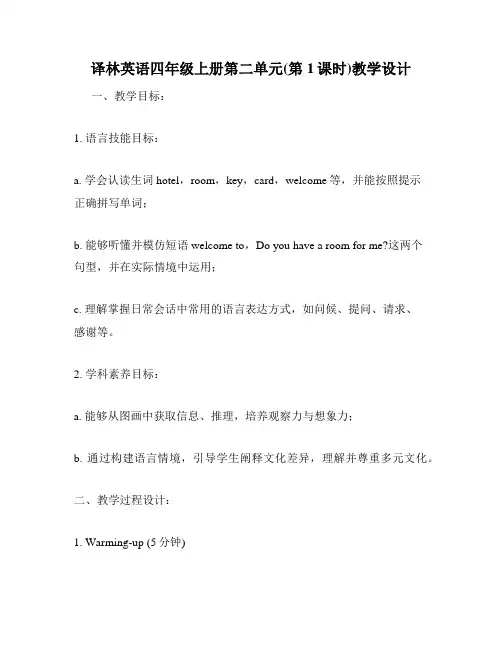
译林英语四年级上册第二单元(第1课时)教学设计一、教学目标:1. 语言技能目标:a. 学会认读生词hotel,room,key,card,welcome等,并能按照提示正确拼写单词;b. 能够听懂并模仿短语welcome to,Do you have a room for me?这两个句型,并在实际情境中运用;c. 理解掌握日常会话中常用的语言表达方式,如问候、提问、请求、感谢等。
2. 学科素养目标:a. 能够从图画中获取信息、推理,培养观察力与想象力;b. 通过构建语言情境,引导学生阐释文化差异,理解并尊重多元文化。
二、教学过程设计:1. Warming-up (5分钟)师生互相问候,以开放式问题引导学生展开短暂而轻松的闲聊。
例如:What's your name? How are you today? Do you like English?2. Presentation (20分钟)a. 通过生动的图片和语音素材,教授新单词hotel,room,key,card,welcome等,并注重鼓励学生多次模仿。
b. 介绍“入住酒店”这一常见场景,并展示酒店前台的相关图片,让学生通过图片感受到酒店大堂的奢华和热闹。
c. 提问What will you say when you enter a hotel?,引导学生说出自己的答案,并在此基础上展示模板句型——Welcome to [hotel name]。
d. 提供一组图片,要求学生根据图片和短语Do you have a room for me?的提示,想象自己和酒店前台进行对话。
e. 教授新单词single room和double room,学生通过观察图片的差异,理解它们的不同含义。
3. Practice (15分钟)a. 运用角色扮演方式,模拟“入住酒店”的情景。
学生分成两组,一组扮演酒店前台,一组是旅客。
旅客在各自的短语卡片上选择合适的语句进行表达,前台需用英语回答。
译林四年级上册Unit 2 教案
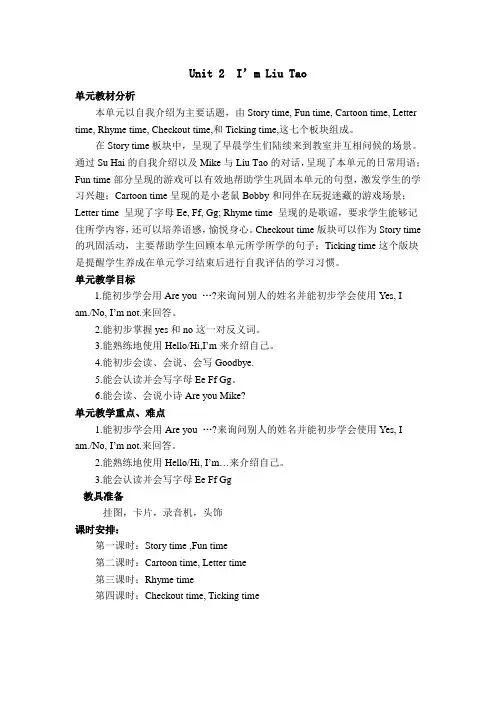
Unit 2 I’m Liu Tao单元教材分析本单元以自我介绍为主要话题,由Story time, Fun time, Cartoon time, Letter time, Rhyme time, Checkout time,和Ticking time,这七个板块组成。
在Story time板块中,呈现了早晨学生们陆续来到教室并互相问候的场景。
通过Su Hai的自我介绍以及Mike与Liu Tao的对话,呈现了本单元的日常用语;Fun time部分呈现的游戏可以有效地帮助学生巩固本单元的句型,激发学生的学习兴趣;Cartoon time呈现的是小老鼠Bobby和同伴在玩捉迷藏的游戏场景;Letter time 呈现了字母Ee, Ff, Gg; Rhyme time 呈现的是歌谣,要求学生能够记住所学内容,还可以培养语感,愉悦身心。
Checkout time版块可以作为Story time 的巩固活动,主要帮助学生回顾本单元所学所学的句子;Ticking time这个版块是提醒学生养成在单元学习结束后进行自我评估的学习习惯。
单元教学目标1.能初步学会用Are you …?来询问别人的姓名并能初步学会使用Yes, I am./No, I’m not.来回答。
2.能初步掌握yes和no这一对反义词。
3.能熟练地使用Hello/Hi,I’m来介绍自己。
4.能初步会读、会说、会写Goodbye.5.能会认读并会写字母Ee Ff Gg。
6.能会读、会说小诗Are you Mike?单元教学重点、难点1.能初步学会用Are you …?来询问别人的姓名并能初步学会使用Yes, I am./No, I’m not.来回答。
2.能熟练地使用Hello/Hi, I’m…来介绍自己。
3.能会认读并会写字母Ee Ff Gg教具准备挂图,卡片,录音机,头饰课时安排:第一课时:Story time ,Fun time第二课时:Cartoon time, Letter time第三课时:Rhyme time第四课时:Checkout time, Ticking time(Period 1)一、教学内容:Unit 2 Story time ,Fun time二、教学目标:1.能初步学会用Are you …?来询问别人的姓名并能初步学会使用Yes, I am./No, I’m not.来回答。
译林版四年级英语上册第二单元教案2篇
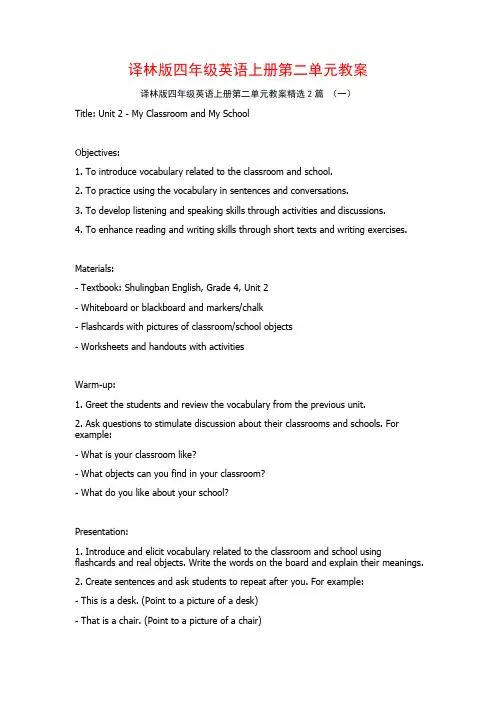
译林版四年级英语上册第二单元教案译林版四年级英语上册第二单元教案精选2篇(一)Title: Unit 2 - My Classroom and My SchoolObjectives:1. To introduce vocabulary related to the classroom and school.2. To practice using the vocabulary in sentences and conversations.3. To develop listening and speaking skills through activities and discussions.4. To enhance reading and writing skills through short texts and writing exercises.Materials:- Textbook: Shulingban English, Grade 4, Unit 2- Whiteboard or blackboard and markers/chalk- Flashcards with pictures of classroom/school objects- Worksheets and handouts with activitiesWarm-up:1. Greet the students and review the vocabulary from the previous unit.2. Ask questions to stimulate discussion about their classrooms and schools. For example:- What is your classroom like?- What objects can you find in your classroom?- What do you like about your school?Presentation:1. Introduce and elicit vocabulary related to the classroom and school using flashcards and real objects. Write the words on the board and explain their meanings.2. Create sentences and ask students to repeat after you. For example:- This is a desk. (Point to a picture of a desk)- That is a chair. (Point to a picture of a chair)Practice:1. Divide the class into pairs or small groups.2. Give each group a set of flashcards or pictures of classroom/school objects.3. Ask each group to arrange the flashcards in different ways, such as by category(e.g., furniture, stationery) or by size (e.g., big, small).4. In rotations, have groups present their arrangements and describe them using the target vocabulary. Encourage students to use complete sentences.5. Monitor and provide guidance as needed.Listening:1. Play a recording of a short conversation about a classroom or school.2. Ask students to listen and answer questions related to the conversation.3. Play the recording again if necessary.4. Discuss the answers as a class.Reading:1. Provide short texts about a classroom or school.2. Ask students to read the texts individually or in pairs.3. Have a class discussion about the texts, focusing on comprehension and key details.4. Ask comprehension questions to check understanding.Writing:1. Provide worksheets with exercises to practice writing sentences using the target vocabulary.2. Have students complete the exercises individually or in pairs.3. Review and discuss the answers as a class.Homework:1. Assign writing tasks where students describe their classrooms or schools using the target vocabulary.2. Encourage students to use complete sentences and include as many details as possible.Assessment:1. Observe and assess students' participation and comprehension during class discussions and activities.2. Review completed worksheets and writing assignments for accuracy and understanding.Notes:- Adapt the lesson plan according to the needs and abilities of the students.- Include additional activities and games to make the lesson more interactive and engaging.- Provide extra support for struggling students and challenge the advanced learners with additional tasks.译林版四年级英语上册第二单元教案精选2篇(二)Unit 1: HelloLesson 1: Greeting and IntroductionsObjectives:- Students will be able to greet and introduce themselves in English.- Students will be able to ask and answer simple questions about personal information.Materials:- Greeting cards with different expressions (e.g. hello, hi, good morning, etc.)- Flashcards of people with names on them- Pictures of different daily activities (e.g. eat, play, sleep, etc.)Procedure:1. Warm-up (5 minutes)- Greet the students with different expressions (e.g. hello, hi, good morning, etc.) and ask them how they are doing.- Ask some students to greet the class using different expressions.2. Introduction (10 minutes)- Show the flashcards of people with names on them. Ask the students to name the people on the flashcards.- Introduce yourself using the flashcards (e.g. Hello, my name is Mark).- Have the students repeat after you and introduce themselves using the flashcards (e.g. Hello, my name is Sarah).3. Vocabulary (15 minutes)- Show the pictures of different daily activities.- Teach and practice the vocabulary words for each activity.- Have the students repeat the words after you and practice using them in sentences (e.g. I eat breakfast in the morning).4. Pair Work (15 minutes)- Divide the class into pairs.- Give each pair a set of greeting cards.- In their pairs, students will take turns choosing a greeting card and using it to greet their partner. They will then introduce themselves and ask and answer questions about their daily activities.5. Group Activity (15 minutes)- Divide the class into larger groups.- Give each group a set of flashcards and pictures of daily activities.- In their groups, students will take turns picking a flashcard and a picture. They will then introduce the person on the flashcard and tell the group what activity they do (e.g. This is Sarah. She eats breakfast in the morning).6. Wrap-up (5 minutes)- Review the vocabulary and expressions learned in the lesson.- Ask students to share one thing they learned about a classmate during the pair and group activities.Assessment:- Observe students' participation and ability to greet and introduce themselves.- Listen for correct pronunciation and usage of vocabulary words.- Monitor students' ability to ask and answer questions about personal information.。
译林版英语四年级上册Unit 2 Let's make a fruit salad教案
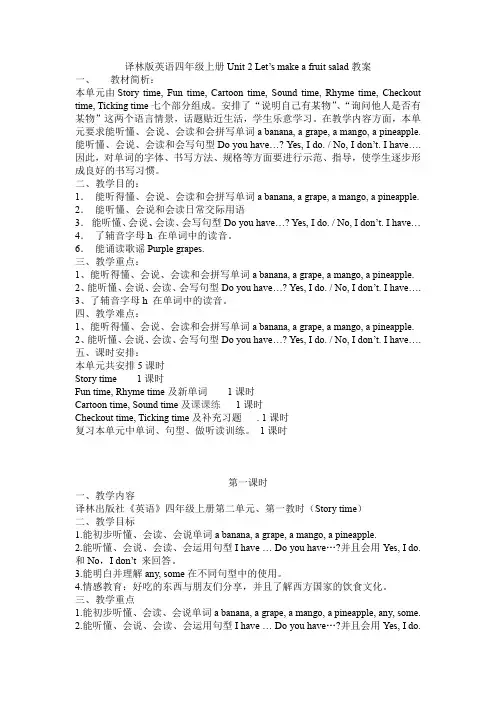
译林版英语四年级上册Unit 2 Let’s make a fruit salad教案一、教材简析:本单元由Story time, Fun time, Cartoon time, Sound time, Rhyme time, Checkout time, Ticking time七个部分组成。
安排了“说明自己有某物”、“询问他人是否有某物”这两个语言情景,话题贴近生活,学生乐意学习。
在教学内容方面,本单元要求能听懂、会说、会读和会拼写单词a banana, a grape, a mango, a pineapple.能听懂、会说、会读和会写句型Do you have…? Yes, I do. / No, I don’t. I have….因此,对单词的字体、书写方法、规格等方面要进行示范、指导,使学生逐步形成良好的书写习惯。
二、教学目的:1.能听得懂、会说、会读和会拼写单词a banana, a grape, a mango, a pineapple. 2.能听懂、会说和会读日常交际用语3.能听懂、会说、会读、会写句型Do you have…? Yes, I do. / No, I don’t. I have…4.了辅音字母h 在单词中的读音。
6.能诵读歌谣Purple grapes.三、教学重点:1、能听得懂、会说、会读和会拼写单词a banana, a grape, a mango, a pineapple.2、能听懂、会说、会读、会写句型Do you have…? Yes, I do. / No, I don’t. I have….3、了辅音字母h 在单词中的读音。
四、教学难点:1、能听得懂、会说、会读和会拼写单词a banana, a grape, a mango, a pineapple.2、能听懂、会说、会读、会写句型Do you have…? Yes, I do. / No, I don’t. I have….五、课时安排:本单元共安排5课时Story time 1课时Fun time, Rhyme time及新单词1课时Cartoon time, Sound time及课课练1课时Checkout time, Ticking time及补充习题. 1课时复习本单元中单词、句型、做听读训练。
译林版英语四年级上册Unit2教案教学内容

译林版英语四年级上册U n i t2教案怀文小学教案专用纸Step 1. Greeting and warming up.T:Nice to see you.S: Nice to see you too.T: Let’s enjoy our English lessons now. Let’s sing a song, OK? Follow me(加动作):Apple treeStep 2.Presentation.1.Free talk:T:Do you know the name of the song? It’s appletree. Do you like apples?S:Yes,I do.(用Unit1的句型复习已学水果单词)2.出示标题。
Apples, pears and oranges are all fruit.Let’s make a fruit salad.Step3. Watch the cartoon.1.Watch and answer: What fruit can you see ?S: I can see a /an/ some…教授单词:banana ,grape, mango, pineapple, fruit. T:I have a/an…(老师出示单词卡或实物). Do you have a banana/grape/mango/pineapple?S:Yes,I do. /No, I don’t.2.Practice先师生问答,再学生分组操练。
T:Do you have …?S:Yes, I do.No, I don’t.板书句型。
让学生发现此句型与第一单元句型的异同之处。
总结Do you…?的回答用语。
Step 4. Reading time1.Read and say.快速阅读课文,身处课文,说说每个人有什么水果。
I’m…I have…2.学生逐图跟读,提醒注意模仿语音语调。
译林英语四上教案Unit 2 Let's make a fruit salad
1.能熟练地听懂、会读、会拼写单词a banana、a grape、a mango、a pineapple;复习水果类单词an orange, a peach,a pear,an apple。
教学难点
能初步会用How many…?询问可数名词的数量。
教学准备
挂图,卡片,多媒体(PPT)
学习过程
S2:A mango.
S3:An orange.
S4:A banana.
S5:A pear.
S6:Some apples.
S7:Some grapes.
T:What are they saying?Let’s watch the cartoon.
1)Read and match
LiuTao a mango and an orange
要求学生独立完成,可以画不同种类的
步骤二:问
步骤三:说
2.Summary
教学内容
Unit2 Let’s make a fruit salad
共6课时
第3课时
总计课时
教
学
目
标
1.能熟练听懂、会读、会拼写本单元单词。
2.能熟练听懂、会说、会读、会运用本单元句型。
教学重点
1.能熟练听懂、会读、会拼写本单元单词。
T:What are these/ those?
S: They’re…
T:What colour is it/are they?
S: They’re…
出示葡萄的图片
学习过程
学生活动
教师导学案
S: You have some grapes.
T:What colour are the grapes?
译林版英语四年级上册Unit2教案
译林版英语四年级上册第二单元教学要求教学内容及课时安排:1.话题和功能:谈论是否拥有某物2.日常用语与句型:I have … /Do you have …? /Yes, I do. /No, I don’t.3.词汇:make, any, banana, some, our, let’s, fruit, salad, pineapple, mango, grape, thanks, cool, wonderful, how many4.歌曲:Do you like purple grapes?5.语音:字母h在单词中的发音。
八课时单元教学目标:1. 知识技能目标能听懂、会说、会读、会运用单词:make, any, banana, some, our.能听懂、会说、会读单词:let’s, fruit, salad, pineapple, mango, grape, thanks,cool, wonderful, how many.能听懂、会说、会读、会运用句型I have …/Do you have …? /Yes, I do. /No, I don’t. 能够正确读出辅音字母Hh的发音,并自己归纳一些词。
会唱歌曲Do you like purple grapes?2. 情感态度目标:学会一些水果类单词,会询问别人是否有某物。
单元教学重点、难点:能听懂、会说、会读、会运用单词:make, any, banana, some, our.能听懂、会说、会读单词:let’s, fruit, salad, pineapple, mango, grape, thanks,cool, wonderful, how many.能听懂、会说、会读、会运用句型I have …/Do you have …? /Yes, I do. /No, I don’t.译林版英语四年级上册第二单元教学设计方案NO:1教学内容Unit2 Let’s make a fruitsalad课型新授课时间教学目的1.能初步听懂、会读单词banana, grape, mango, pineapple, salad, make2.能听懂、会说、会读句型I have…Do you have a…?及其回答。
新译林版英语四年级上册Unit 2 2教案
Unit 2 Let’s make a fruit salad 第二课时教学内容:1、复习稳固句型:I have…Do you have a… 并进一步学习I have some…Do you have any… Yes, I do./No, I don’t.2、复习词汇: banana, grape, mango, pineapple并学习它们的复数表达以及发音,注意mango,是在后面加-es。
3、学生能使用以下日常交际用语:Thanks. Look at our fruit salad.4、学生能初步了解some与any的异同以及使用方法。
5、学生通过课文对话的表演,了解分享与合作的快乐。
教学重点:1、复习稳固句型:I have…Do you have a… 并进一步学习I have some…Do y ou have any… Yes, I do./No, I don’t.2、复习词汇: banana, grape, mango, pineapple并学习它们的复数表达以及发音,注意mango,是在后面加-es。
教学难点:学习I have some…Do you have any… Yes, I do./No, I don’t. 同时,学生能初步了解some与any的异同以及使用方法。
教学过程:1、游戏引入,复习词汇(1)猜谜游戏复习水果词汇T: It’s little. It’s purple and green. What is itS: It’s a grape.T: Great.T: It’s big. It’s yellow and orange. What is itS: It’s a pineapple.T: It’s yellow and sweet. What is itS: It’s a banana/mango.(2) pick and say〔学生根据他们选取的图片或实物进行对话〕-I have a….Do you have a…-Yes, I do. No, I don’t.(3)歌谣T: Do you like purple grapesS: Yes, I do.T: Let’s sing this song together2、改编歌曲,引入新知(1)T:Today let’s try to make a new s ongDo you have , ,Yes, I have .Oh, they are nice and sweet.(可以运用在其中的词组有:yellow mangoes; orange pineapples; yellow bananas)(2) Listen and match〔设计思路:教师根据听音连线的活动,了解课文大意。
译林版四年级英语上册第二单元教案
译林版四年级英语上册第二单元教案译林版四年级英语上册其次单元教案1一、【教材分析】(一)教学内容本节课是外语教学与讨论出版社出版的《新标准英语》三年级起点第六册Module10 Unit1的课文教学,课文通过Daming和奶奶的电话谈话,呈现教学的主要内容,即Daming旅行前的预备。
课型为新授课。
本单元学习的主要目的是在深入理解课文内容的根底上,使学生学会运用what,where,when,who,how等特别疑问词来谈论旅行预备;使学生通过合作学习体验荣誉感和成就感,从而树立自信念,进展自主学习的力量,形成用英语进展简洁日常交际的力量。
同时让学生学会一种正确对待生活的方式,明白做任何事都要有打算,避开盲目性,表达了英语学科与生活实际的严密结合。
(二)学情分五年级的学生对英语学习已经有了肯定的阅历并养成了良好的学习习惯,他们对英语学习有着深厚的兴趣。
他们渴望获得更多的熬炼时机。
经过前几个模块的学习,学生已经初步把握了如何询问他人已做过的事情,这样,学生已把握的学问和心理状态为本节课的自主探究学习打下了根底(三)教学目标新英语课程标准指出,根底训练阶段英语课程的总体目标是培育学生的综合语言运用力量。
而综合语言运用力量又以学生语言技能、语言学问、情感态度、学习策略和文化意识五个方面的综合素养为根底。
以此为依据设定以下目标。
1、语言学问目标(1) 让学生能听、说、认、读list, airport、shoes ticket, toothbrush. 等单词。
(2) 通过学习让学生娴熟把握句型:Where are you going to go? What are you going to take?When are you going to go to the airport?Who’s going to go to the airport?(3)能听懂、认读以“where、what、when、who”四个单词开头的疑问句。
- 1、下载文档前请自行甄别文档内容的完整性,平台不提供额外的编辑、内容补充、找答案等附加服务。
- 2、"仅部分预览"的文档,不可在线预览部分如存在完整性等问题,可反馈申请退款(可完整预览的文档不适用该条件!)。
- 3、如文档侵犯您的权益,请联系客服反馈,我们会尽快为您处理(人工客服工作时间:9:00-18:30)。
T: Yes. You’re clever. I have some grapes.
T: What are they? Fruit or animals?
Ss: Fruit.
T: Right.They’re fruit.教师领读fruit,学生跟读。
T: Let’s make a fruit salad. OK?
T: It’s big. It’s yellow and green. What is it?
S1: Is that a pear?
T: No. It’s apineapple. I have a pineapple.
T: It’s yellow. Is that an orange?
S2: No.
7.Act it out.
组织学生根据本课场景六人一组表演对话。学生上台表演时,建议可以给参与表演的学生戴上人物头饰,并准备好对话中所需的物品,使学生的对话表演更加真实、有趣。
Step 3 Summary
让学生自己总结本课所学内容。
板书设计
作
业
设
计
1.熟读Story time,并尝试背诵。
2.抄写水果单词,英文四遍,中文一遍。
4.初步理解some和any的用法。
课
前
准
备
教师
多媒体课件,水果的图片
学生
预习Unit 2 Story time
教学过程
教学随笔
课始五分钟:
1.Greetings
T: Good morning, boys and girls.
Ss: Good morning, Miss Tang.
T: How are you?
教学重点、难点
1.能听懂、会说、会读、会写单词banana, some.
2.能听懂、会说、会读单词let’s, fruit, salad, pineapple, mango, thanks.
3.能听懂、会说、会读句型I have ...Do you have...?以及答句Yes, I do./ No, I don’t.
T: Right. It’s a mango. I have a mango.
T:Whatare these? They’re yellow. Are thesepears?
Ss: No. They’re not pears.
T: Right. They’re bananas.
T: They’re purple. What are those?
2.能听懂、会说、会读单词let’s, fruit, salad, pineapple, mango, thanks.
3.能听懂、会说、会读句型I have ...Do you have...?以及答句Yes, I do./ No, I don’t.
4.初步理解some和any的用法。
5.了解西方国家的饮食文化。
泰州市城东中心小学(辅导区)2019—2020学年度第一学期
四年级英语 学科备课教案纸
课 题
Unit2 Let’s make a fruit salad
课时安排
单元总(5)课时
设计者
审阅人
送审时间
备注
教材分析
第一课时
教学内容
Unit2Story time
教学
方法
任务教学法
执教时间
第( )周
教学目标
1.能听懂、会说、会读、会写单词banana, some.
S1:A pineapple;
S2: A mango and an orange.
S3: Some grapes and a banana.
4.Read and match.
T: What fruit do they have?他们分别都有哪些水果?
Liu Tao a mango and an orange
S1:I’mfine, And you?
T: Yes, I’m fine, too.
T: Look at your T-shirt . How nice!
S2: Thank you.
2.Warm up—Sing a song.“Apple tree”
T:Whatfruit do you hear?
Ss: Apples.
T: Do you like apples?
S1:Yes,I do.
T: What about you?
S2:I like apples,too.
同时复习了前一单元所学的内容。
Step1Presentation
1.教师呈现三年级下册第七单元农场的场景,将本课要学习的水果单词放入该场景中,引出单词a pineapple, a mango,a banana以及somegrapes.
Ss: OK.
T: Today we’ll learn Unit2 Let’s make a fruit salad.(揭示课题)
2.Saya chant.
I have an apple, red and sweet.
I have a pineapple, yellow and green.
I have some bananas, Come and eat.
Ss: They’re…
2.Watch the cartoon.
T:Whatare they talking about?看课文动画,他们正在谈论些什么?
Ss: They’re talking about fruit.
3.Listen and answer.
T:What fruit are they talking about?
Wang Bingsome apples
Mikea pineapple
Su Haisome grapes
YangLinga banana and an orange
5.Read after the tape.
6.Read after the teache注意模仿录音中的语音语调,然后安排学生在小组内分角色朗读。
I have fruit. Let’s make a fruit salad.
通过创编简单的儿歌,引导学生用新学的单词完成儿歌,帮助学生巩固新词,进一步为课文的呈现做好铺垫。
Step 2 Story time
1.Try to say
T: Look at the pictures, Who are they ?Where are they?
